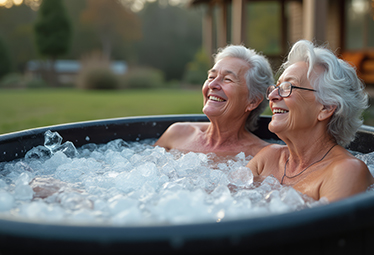 Cryotherapy, or cold therapy, is a treatment technique increasingly used to relieve pain, improve muscle recovery and promote general well-being. Initially used in the sports world to accelerate regeneration after exercise, it is now appealing to a wider audience looking for natural solutions to joint and inflammatory pain.
Cryotherapy, or cold therapy, is a treatment technique increasingly used to relieve pain, improve muscle recovery and promote general well-being. Initially used in the sports world to accelerate regeneration after exercise, it is now appealing to a wider audience looking for natural solutions to joint and inflammatory pain.
What is cryotherapy?
Cryotherapy consists of exposing the body or part of the body to extremely low temperatures, up to -150°C, for a period generally between 1 and 3 minutes. There are several types of cryotherapy:
- Whole-body cryotherapy (WBC): the patient enters a cold room or a specific cabin where their body is exposed to intense cold for a few minutes.
- Localised cryotherapy: a specific area of the body is treated with a jet of liquid nitrogen or a device that diffuses intense cold onto the skin.
- Ice baths: a more accessible method, used in particular by athletes, which consists of immersing part or all of the body in very cold water.
The benefits of cryotherapy
A powerful natural painkiller
Cold acts as a natural anaesthetic by slowing down the transmission of nerve signals linked to pain. It is particularly effective in relieving muscle and joint pain, especially that caused by osteoarthritis, rheumatism or sports injuries.
Better muscle recovery
After intense physical exertion, the muscles can be sore due to the micro-injuries suffered. Cryotherapy reduces inflammation and improves blood circulation, which promotes faster recovery and reduces the risk of soreness.
A beneficial effect on blood circulation
Exposure to the cold causes vasoconstriction (narrowing of the blood vessels), followed by vasodilation once the body warms up. This stimulates the blood and lymphatic circulation, improving tissue oxygenation and the elimination of toxins.
An ally against inflammation and chronic conditions
Cryotherapy is particularly beneficial for people suffering from inflammatory diseases such as arthritis, fibromyalgia or tendinitis. By reducing inflammation, it helps to alleviate symptoms and improve patients' quality of life.
A boost for morale and vitality
The thermal shock caused by the cold stimulates the production of endorphins, also known as the happiness hormones. This provides an immediate feeling of well-being and helps to combat stress, anxiety and even certain forms of depression.
Cryotherapy for seniors: a suitable solution?
With age, joint pain, circulatory problems and general fatigue become more frequent. Cryotherapy is an interesting solution for improving mobility, reducing chronic pain and restoring energy for everyday life. It is particularly recommended for people suffering from osteoarthritis, muscle pain or blood circulation problems.
However, certain precautions should be taken: people suffering from cardiovascular disorders, uncontrolled hypertension or respiratory problems should consult a doctor before undertaking cryotherapy sessions.
Can cryotherapy be combined with other natural therapies?
Yes! To maximise the benefits of cryotherapy, it can be combined with other complementary methods, such as:
- Magnet therapy: the use of therapeutic magnets can prolong the beneficial effects of cryotherapy by improving blood circulation and reducing pain in the long term.
- Hydrotherapy: alternating hot and cold baths stimulates circulation and reinforces the benefits of the cold on the body.
- An anti-inflammatory diet: a diet rich in omega-3, antioxidants and unprocessed foods helps to reduce inflammation and improve joint comfort.
Cryotherapy, a therapy to adopt?
Cryotherapy is an effective and natural method for relieving pain, improving muscle recovery and boosting general well-being. This technique offers many advantages for athletes, people suffering from chronic pain and seniors looking for a better quality of life. However, it must be practised under medical supervision and adapted to each individual according to their needs and state of health.



